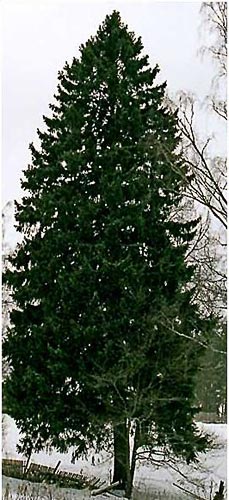Relatives
Picea abies Karst. - Norway Spruce.
Taxonomic position.
Family Pinaceae Lindl. genus Picea A.Dietr.Morphology and biology.
Evergreen tree 30-50 m tall with sharply pyramidal crown and red-brown or grey bark, flaking by thin scales; young branches glabrous or slightly pubescent; leaves triquetrous, very densely arranged, raised up, nitid, dark green, 20-30 mm long and 3 mm wide, persistent on tree up to 5-7, sometimes 9 years; male cones between leaves, surrounded at base with light green bracts, 20-25 mm long, purple-red; young cones at apices of biennial shoots elongate-cylindrical, bright red, later turning green, by maturity turning brown, mature ones pendant, 10-16 cm long and 3-4 cm diameter, their scales obovate, convex, undulate or notched-dentate at margin; seeds ovate, acute, dark brown, 4 mm long, wing yellow-red, 3 times longer; seeds disseminate in early spring, and open cones hang on tree for a long time. Monoecious, anemophilous, anemo- and in a lesser degree ornitho- and zoochore.Distribution.
Forest zone of European part of the former USSR up to the Kama River basin in the east, Carpathians; West Europe.Ecology.
One of main forest-forming species of dark coniferous taiga.Use and economic value.
Valuable timber tree.References:
Sokolov SI., Svjaseva OA., Kubli VA. 1977. Ranges of trees and shrubs of the USSR. V.1. Leningrad: Nauka. 240 p. (In Russian).Tolmachev AI., ed. 1974. Flora of the Northeast of European part of the USSR. V.1. Leningrad: Nauka. 275 p. (In Russian).


